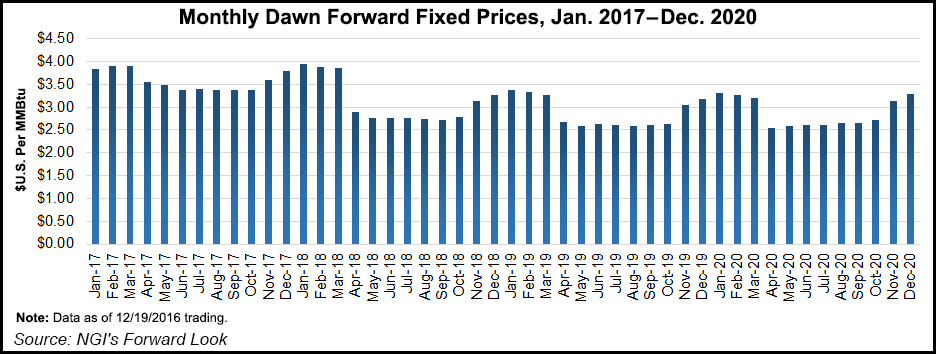Regulatory | Infrastructure | NGI All News Access
FERC Must OK Construction by End of Month to Avoid Delay, Rover Says
Rover Pipeline LLC is urging FERC to approve its certificate application by the end of this month, warning that if it can’t start tree clearing by mid-January the project “very likely will be delayed for up to a full year.”

Rover, an affiliate of Energy Transfer Partners LP, filed a letter Friday [CP15-93] asking the Federal Energy Regulatory Commission to take immediate action and approve the project.
Rover received its final Environmental Impact Statement (EIS) from the Federal Energy Regulatory Commission in July but has been waiting on a final decision from the Commission so it can begin construction. In order for Rover to “comply on a timely basis” with conditions established in the EIS, FERC would need to approve its application by “no later than December 2016,” the company said.
At issue is the U.S. Fish and Wildlife Service’s approved seasonal windows for tree clearing activities designed to limit impacts on the federally-protected Indiana and northern long-eared bats, according to Rover. The approved window for tree clearing along Rover’s route ends March 31 and wouldn’t reopen until the fall.
The 710-mile, 3.25 Bcf/d Rover would connect Marcellus and Utica shale gas to the Midwest Hub in Defiance, OH, and to an interconnection with the Vector Pipeline in Michigan, giving Appalachian producers access to points like the Dawn Hub in Ontario.
In Friday’s letter to the Commission, Energy Transfer Executive Vice President of Engineering and Construction Joey Mahmoud stressed the importance of Rover meeting its scheduled in-service date. Rover is over 95% subscribed, with 3.1 Bcf/d of the total 3.25 Bcf/d under long-term firm contracts, Mahmoud said.
“This is a matter of significant concern to Rover’s producer-shippers that have made major capital investments and have committed to production and delivery schedules on the basis of Rover’s projected in-service dates,” Mahmoud wrote. “Continued delays in project execution will have devastating implications for these producer-shippers who have over 1.55 Bcf/d of natural gas scheduled to begin flowing in July 2017 and up to 3.15 bcf/d starting in November 2017.”
He added, “The negative financial consequences resulting from a failure to start Project construction by mid-January 2017 will also will be felt directly by approximately 15,000 construction workers and nearly 2,000 non-construction workers, including surveyors, engineers, environmental specialists, pipeline inspectors, outreach and right-of-way professionals, among others, who are all waiting to begin work on the project.”
Rover has targeted a 2Q2017 in-service date for service to Defiance, OH, with service to Vector and the Dawn Hub scheduled for late 2017.
Meanwhile, FERC’s review process hit a snag last month after it learned that Rover demolished “the Stoneman House,” a historic home in Dennison, OH, outside the Commission’s knowledge.
The home, built in 1843, stood across the street from Rover’s proposed Mainline Compressor Station 1 and would have fallen “within the visual area of potential effects for this project component,” according to FERC. Determining that the home’s destruction may have violated the National Historic Preservation Act, FERC began consulting with the Advisory Council on Historic Preservation (ACHP) to make sure circumstances justify moving forward with the review under federal law.
FERC told the ACHP on Dec. 5 that “Commission staff believes that the applicant’s stated purpose and need for the project…justify continuing review, to allow the Commission to address public interest issues raised by the project.”
The ACHP said in a letter to FERC Friday that it agrees that the potential for Rover to “provide gas consumers with access to readily-available, stable and competitively-priced gas supplies” does justify “further consideration of the undertaking despite the significant adverse effects caused to the historic property. While the Stoneman House was demolished entirely, so the property no longer retains any integrity, the ACHP finds FERC’s position reasonable and does not object to it.”
FERC should consider “making a determination of adverse effect” for the project that recognizes the historic home’s demolition, the ACHP wrote. This “would lead to consultation” with state historic preservation offices (SHPO) in West Virginia, Pennsylvania, Michigan and Ohio, as well as “other consulting parties,” according to the agency. FERC and the consulting parties would then need to develop a “memorandum of agreement” or “programmatic agreement” documenting the resolution of any adverse effects.
Rover had already made arrangements to pay Ohio’s State Historic Preservation Office to compensate for the destruction of the Stoneman House, with Rover agreeing to $1.3 million in “financial mitigation,” according to natural gas analytics firm Genscape.
“While the measures negotiated by Rover and the Ohio SHPO regarding the Stoneman House are laudable and would be directly relevant to the consultation to resolve adverse effects of the undertaking,” the ACHP wrote Friday, “we remind FERC that consultation on appropriate measures should also include parties that may be concerned about the demolition of the Stoneman House and/or any other adverse effects.”
The ACHP said it is “sensitive to Rover’s need for timely action” and would be available to help FERC and Rover “in expeditiously moving forward” with the review.
Rover’s first phase of construction to Defiance, OH, is the next major capacity increase scheduled to come online for the capacity-constrained Appalachian Basin.
Management for Denver-based Antero Resources Corp., which is expecting as much as 800 MMcf/d of additional capacity on Rover, said during a 3Q2016 conference call that its Utica production was essentially capped at 600 MMcf/d as of October due to limited westbound takeaway.
“What is the next shoe to drop?” CEO Paul Rady said. “The next event that we’re looking forward to is Rover coming to the Utica play. We estimate that it’s scheduled to be built to our Seneca outlet sometime between mid-2017 and the end of 2017. So that’s what’s constraining us and keeping us maxed.”
© 2024 Natural Gas Intelligence. All rights reserved.
ISSN © 1532-1231 | ISSN © 2577-9877 |
